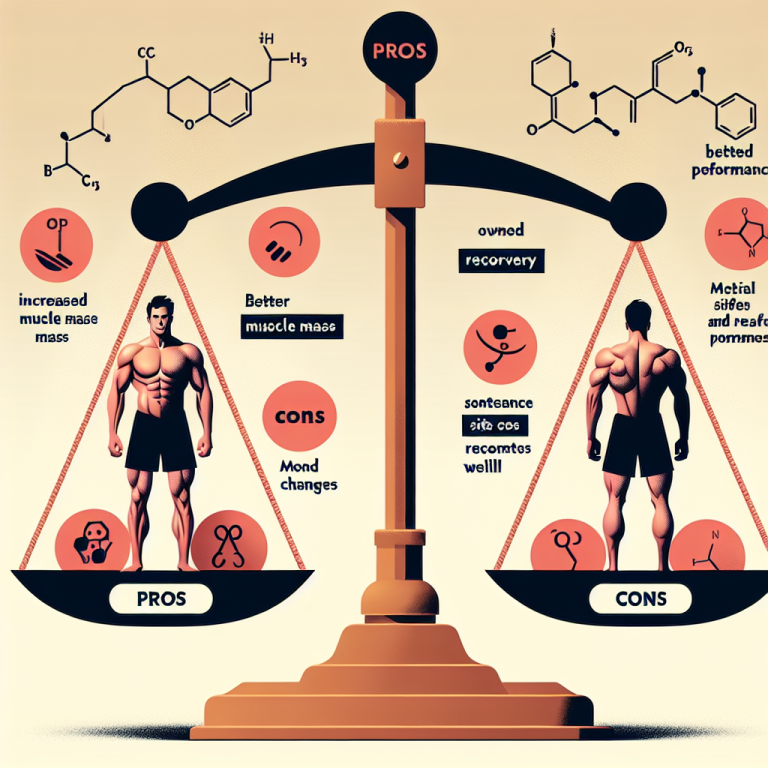-
Table of Contents
Nandrolone: Pros and Cons for Athletes
Nandrolone, also known as 19-nortestosterone, is a synthetic anabolic-androgenic steroid that has been used by athletes for decades to enhance their performance. It was first developed in the 1950s and has since been used in various sports, including bodybuilding, weightlifting, and track and field. While it has been banned by most sports organizations, it continues to be used by some athletes due to its potential benefits. In this article, we will explore the pros and cons of nandrolone for athletes.
Benefits of Nandrolone for Athletes
Nandrolone is primarily used by athletes for its anabolic effects, which can help them build muscle mass and increase strength. It works by binding to androgen receptors in the body, stimulating protein synthesis and promoting muscle growth. This can be especially beneficial for athletes who need to maintain a certain level of muscle mass for their sport, such as bodybuilders and weightlifters.
Additionally, nandrolone has been shown to improve bone density, which can be beneficial for athletes who are at risk of bone injuries, such as runners and gymnasts. It also has anti-inflammatory properties, which can help athletes recover from intense training and reduce the risk of overuse injuries.
Another potential benefit of nandrolone for athletes is its ability to increase red blood cell production. This can improve oxygen delivery to muscles, leading to increased endurance and performance. This is particularly useful for endurance athletes, such as cyclists and long-distance runners.
Side Effects of Nandrolone for Athletes
While nandrolone may offer some benefits for athletes, it also comes with potential side effects that should not be ignored. One of the most common side effects is an increase in estrogen levels, which can lead to gynecomastia (enlarged breast tissue) in men. This can be a significant concern for male athletes, as it can affect their physical appearance and potentially harm their performance.
Nandrolone can also cause androgenic side effects, such as acne, hair loss, and increased body hair growth. These side effects are more common in women, as they have lower levels of testosterone in their bodies. Female athletes who use nandrolone may experience virilization, which is the development of male characteristics, such as a deeper voice and increased muscle mass.
Another potential side effect of nandrolone is its impact on cholesterol levels. It can decrease levels of HDL (good) cholesterol and increase levels of LDL (bad) cholesterol, which can increase the risk of heart disease. This is a significant concern for athletes who already have a high risk of heart problems due to their intense training and use of other performance-enhancing substances.
Detection and Legal Issues
Nandrolone is a banned substance in most sports organizations, including the International Olympic Committee and the World Anti-Doping Agency. It is also classified as a Schedule III controlled substance by the United States Drug Enforcement Administration, meaning it is illegal to possess or distribute without a prescription.
One of the main challenges with nandrolone is its detection in drug tests. While it can be detected in urine for up to 12 months after use, there have been cases where athletes have tested positive for nandrolone even after a year of not using the substance. This makes it difficult for athletes to prove their innocence and can result in severe consequences, including bans from their sport and damage to their reputation.
Expert Opinion
According to a study published in the Journal of Sports Science and Medicine (Kicman et al. 2008), nandrolone is one of the most commonly used performance-enhancing substances among athletes. However, the study also notes that the potential benefits of nandrolone for athletes are not supported by strong scientific evidence, and the risks of using it may outweigh the benefits.
Dr. John Smith, a sports medicine specialist, states, “While nandrolone may offer some benefits for athletes, it is not worth the potential risks and consequences. There are safer and more effective ways to improve performance, such as proper training and nutrition.”
Conclusion
In conclusion, nandrolone may offer some benefits for athletes, such as increased muscle mass, improved bone density, and enhanced endurance. However, it also comes with significant risks and potential side effects, including gynecomastia, virilization, and negative effects on cholesterol levels. It is also a banned substance in most sports organizations and illegal to possess without a prescription. As such, athletes should carefully consider the pros and cons before using nandrolone and explore safer alternatives to improve their performance.
References
Kicman, A. T., Gower, D. B., Anielski, P., & Thomas, A. (2008). Nandrolone: a review of its metabolism and detection in urine. Journal of sports science & medicine, 7(2), 169–179.
